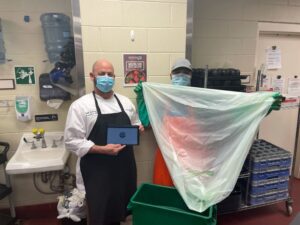How Morrison Healthcare is Helping Hospitals Stop Food Waste
As we get ready to celebrate Stop Food Waste Day on April 28th, Morrison Healthcare’s use of new technology is helping it to make major gains in reducing food waste while also rescuing tons of food and donating it to local food banks across the nation.
In September 2020, Morrison launched Waste Not 2.0, a software designed to track food waste in hospital kitchens across the nation. To date, 77 Morrison locations use the technology, with another 14 set to implement it soon.
While Morrison has been tracking food waste since 2017, the new technology makes it easier to track. It reports food waste for each location and provides data and analysis to help identify additional areas of opportunity. The technology is helping Compass Group North America meet its long-term commitment to reduce food waste by 50% by the year 2030.
Here’s how three Morrison chefs are working to stop food waste:
David Slabaugh Whiteside, Regional Executive Chef

We’ve been using Waste Not 2.0 since June of 2020. Using computer tablets set up in six of their kitchens, the software records the waste throughout the entire chain of food production and delivery. For example, we throw out seeds and skins from foods such as cantaloupes; food that is expired and no longer safe to eat; leftovers from the catering staff.
Every level of the culinary staff is involved. The utility team collects food waste in the dish room being returned from service lines, and the production team tracks trim and production errors. The chefs review the data and recommend changes in our processes to eliminate waste. They also identify food that can be rescued and donated to their local community.
As a result, we’ve compiled some impressive results so far this year:
- We’ve collected 2.7 tons of waste through March across our 1,300-bed hospital.
- Two tons went to composting
- 25 percent was donated to local food banks
Best Practice: Involving our entire team in the use of the Waste Not 2.0 technology has also helped us better understand trends and capture more waste. After analyzing the amount of waste by each shift, we found that our breakfast service consistently had the most waste. It had gone unnoticed before because by the time breakfast trays came back, our kitchen staff was already busy preparing lunch. Our solution was to train our utility and dishwasher teams to weigh overproduction and we were on our way to reducing breakfast waste.
David Topping, Regional Executive Chef, Roper St. Francis Healthcare, Charleston, S.C.
Since starting our program in September 2020, we reduced our red (avoidable) food waste by a stunning 45 percent. Cutting our food waste has meant savings in food costs; the less food we need to order, the better it is for the planet and our client.

There are five kitchens in the hospital where we hang our Waste Not 2.0 computer tablets to record waste. Each day, our cooks grab their cutting boards, knives, and buckets to get rid of any waste. They take the trim from fruits, vegetables, and meat when prepping to a collection bin for overproduction. After the prep work is done, we measure the amount in the buckets and record it on the tablets.
An important key to our results is the ongoing staff training. During our daily production, retail, and patient services line-ups, we discuss waste reduction and provide monthly reports on our progress.
Waste Not 2.0 has helped us buy less food. Most kitchens are concerned about running out of food. This data helps our purchasing team better understand the importance of not making too much food that ends up as waste. If our overproduction rate is falling, we aren’t wasting as much food.
And of course, the hospital’s administration and medical staff see benefits to cutting food waste, because at the end of the day, stopping food waste results in cost savings for our client.
Best Practice: Jeff Lentini, our System Director, delivers a quarterly business report to show how our measures to stop food waste can save money. They see that we are purchasing less food, we aren’t overstocked, and don’t need to throw food away.
Michael Firth, Senior Executive Chef, Methodist University Hospital, Memphis, Tenn.
Working closely with The Original Project, a food sustainability organization, we’ve established a food rescue program that is helping to feed a wide variety of people in the Frayser and Orange Mounds communities of Memphis.
As of March 1st, we have distributed 3,952 pounds of food – nearly two tons – to families and individuals in Shelby and Tunica counties this year. These donations are the result of an ambitious Stop Food Waste program at the hospital that has enabled us to keep unused food fresh.
As a result, each month we are providing more than 500 healthy, nutritious meals. We are reaching a broad population, helping feed students in the Shelby County schools, homeless women and children, and senior citizens in these two counties.
Our contributions consist largely of leftover starches and vegetables. Beginning in April, we also began donating unused portions of animal proteins, such as chicken, as well. Every Thursday evening, food boxes are picked up and delivered to area shelters and families. Some food also goes to a makeshift neighborhood restaurant where people can pick up “to go” plates.
We are proud to work closely with Austin Avery, chief executive officer at The Original Project Team. He started the food rescue program to help eradicate food insecurity and food deserts in Memphis. The program is a perfect fit for our Stop Food Waste effort since we can feed those in the community who otherwise may go hungry.




